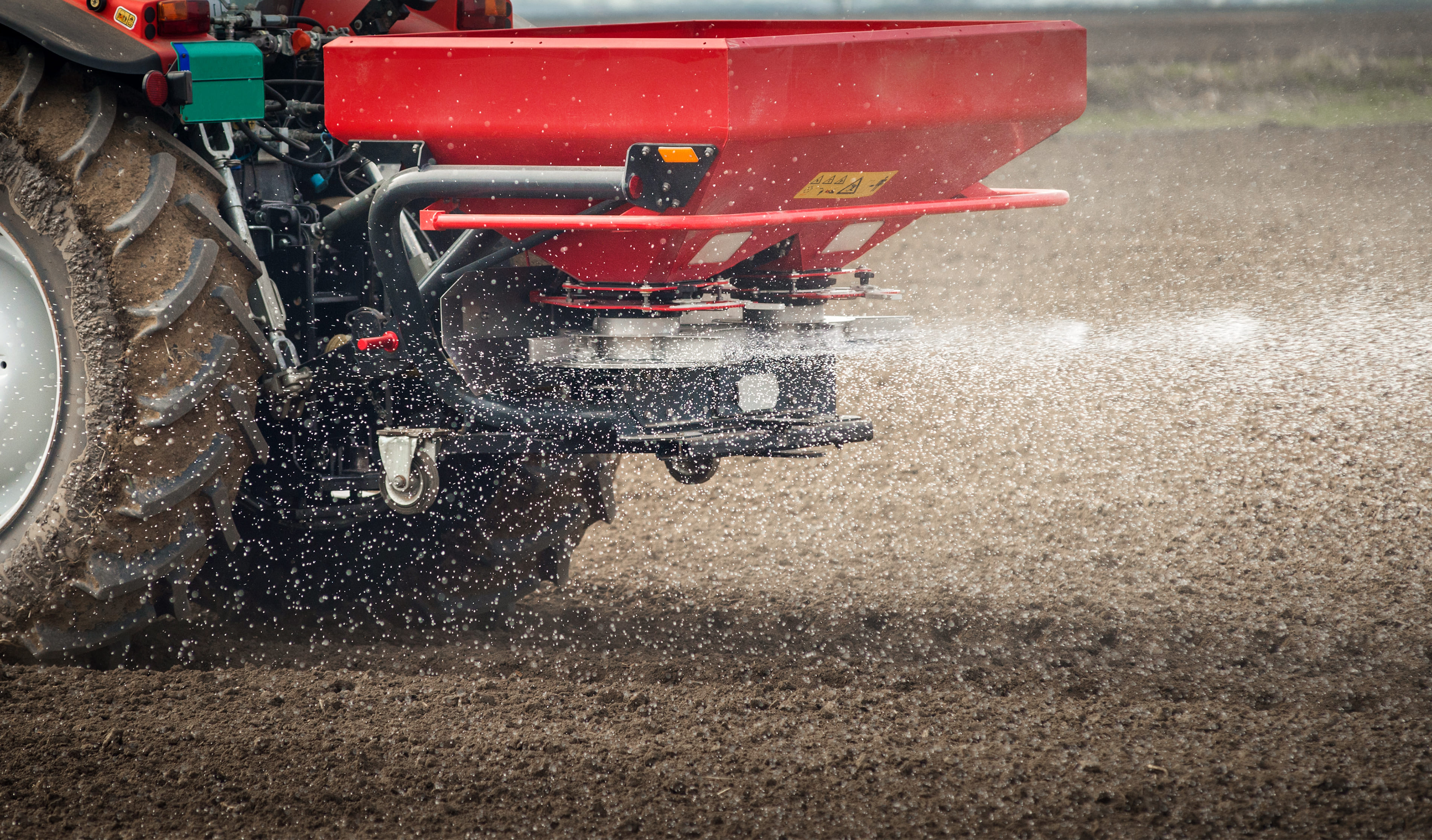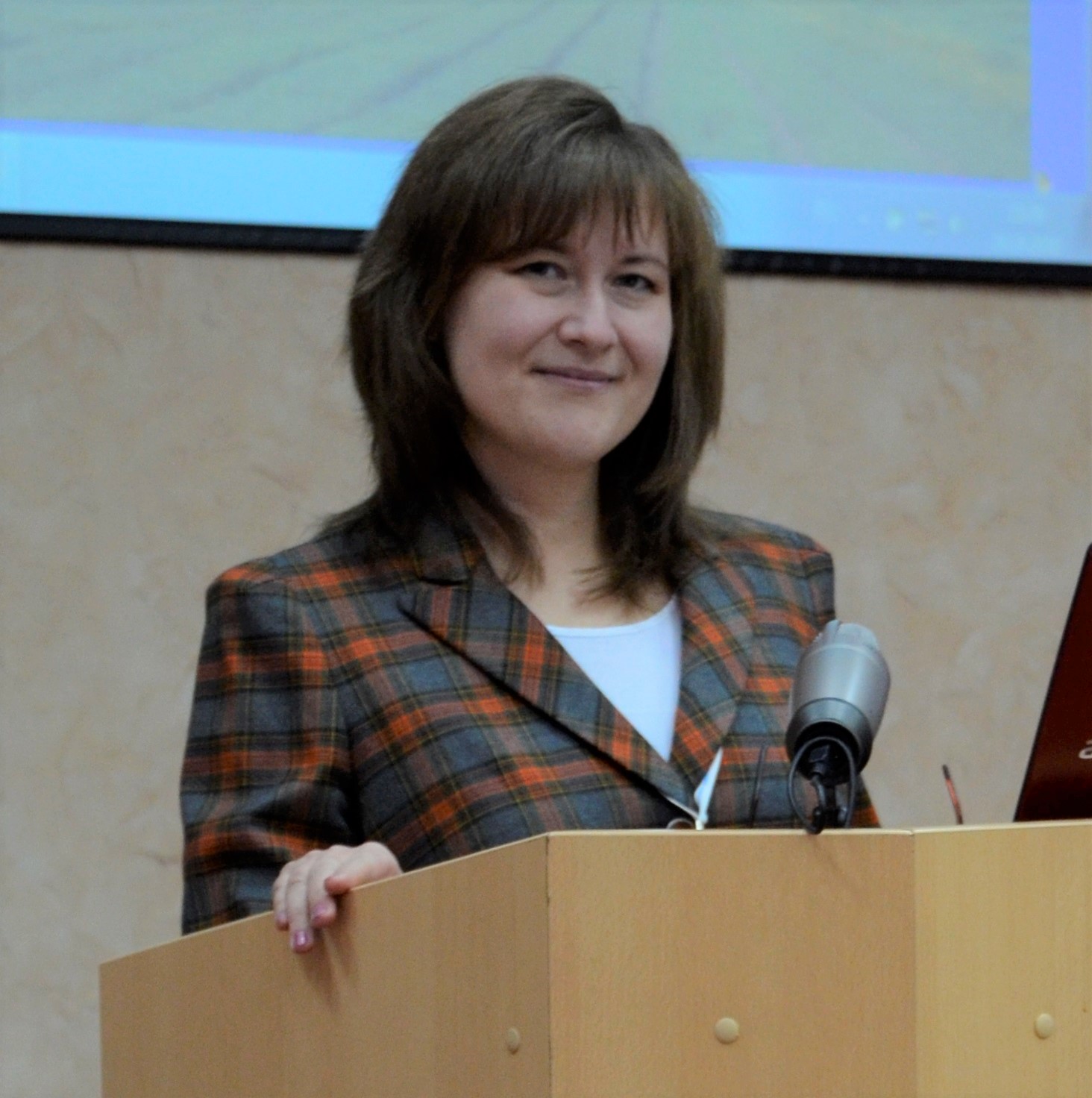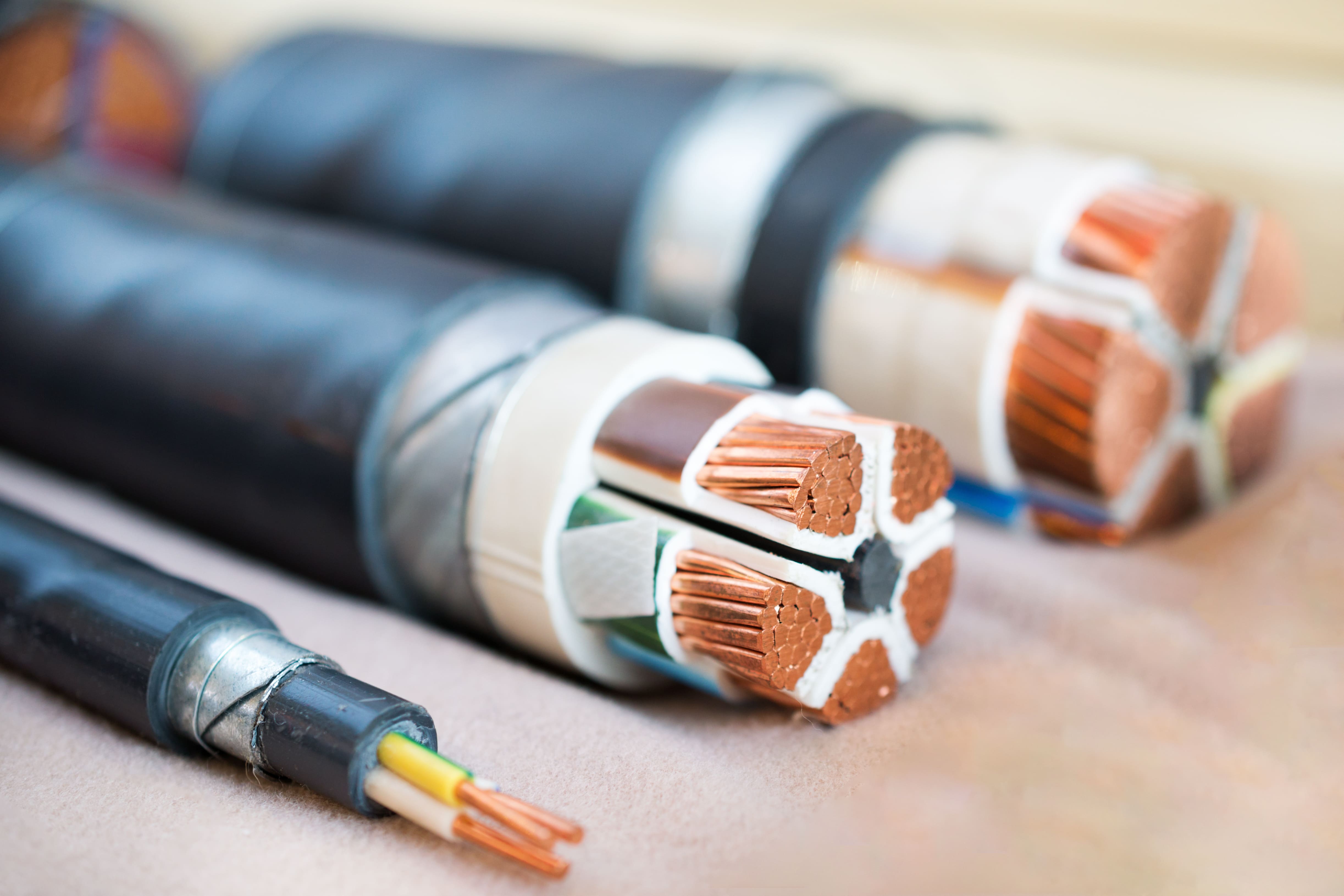Oil crop production is important for the development of the country's economy. The resulting products provide raw materials for many related segments of agro-industrial sector, and it is therefore important to obtaining high yields of quality oilseeds.
According to data from Rosstat, the area sown with oil crops amounted to 18.8 million hectares in 2024, 7 million hectares (71%) higher than in 2013. Of this area, sunflowers accounted for 9.7 million hectares, soybeans 4.3 million hectares, and rape 2.7 million hectares.In addition, modern agronomists are able to increase the gross yield of crop production not only by increasing the area, but also by obtaining higher yields of high quality seeds per unit area through the use of optimized agro-technologies, including a competent nutrition system for new high-yielding varieties and hybrids.
Over several years of conducting research and production field experiments, Brucite+ has studied the effect of magnesium fertilizers (Table 1), derived from brucite, a naturally occurring form of magnesium hydroxide, in increasing the yield of oil crops.
| Indicator name | AgroMag® granulated | AgroMag® granulated MgO+B grade 57:1* | AgroMag® granulated MgO+S grade 49:20* | AgroMag® AktiMax |
|---|---|---|---|---|
| Nutrient content, % | ||||
| MgO | 61.4 | 57 | 49 | 34.6 |
|
S (in terms of SO3) |
— | — | 20 | — |
|
B |
— | 1 | — | — |
| CaO | 2.9 | 1.5 | 1.5 | 1.7 |
| N | — | — | — | 3.8 |
| Physical properties | ||||
| Appearance | Light gray granules | Light gray to light yellow granules | Stabilized white aqueous suspension | |
| Percentage by mass of granules of size 1-4mm, % | 90 | — | ||
Granular fertilizers were applied at the time of plowing, spring tilling or sowing. Leaf fertilizers were applied at critical phases of plant development, viz:
-
for soybeans – 2 applications: at the 4th triple leaf stage and the flower-bud formation stage or the beginning of grain filling (depending on the objectives of the experiment);;
-
for sunflower – 1 application at the 4-6 leaf pair stage;
-
for rape – 2 leaf fertilizers: at the rosette stage and the stemming stage.
The results of the effectiveness of supplementing the nutrition system of oilseeds in different soil and climatic conditions with magnesium, sulfur, boron from AgroMag® granular fertilizers and magnesium by means of leaf fertilization with AgroMag® AktiMax suspension are presented in Tables 2-4 and Figures 1-3.
Application of fertilizers in the AgroMag® line in different doses and combinations promoted more a balanced nutrition of soybean plants and better assimilation of basic nutrition elements from different soils and NPK – fertilizers, which led to an increase in yield of 1.7 – 8.7 kg/ha (9 – 33 %) depending on the region (Table 2).
| Region, soil | Fertilizer* | Yield in experimental plants | Yield increase** | |
|---|---|---|---|---|
| hundred kilograms/ha | % | |||
|
FEFD, Amur region. Chernozem meadow soil (average over 2 years) |
AgroMag® gr., 50 kg/ha for tilling |
22.0 | 2.2 | 11 |
|
АМ, 3 l/ha x 2 applications |
22.3 | 2.5 | 13 | |
|
CFD, Belgorod region. Typical chernozem soil (average over 2 years) |
AgroMag® gr., 115-122 kg/ha for tilling + AM, 4L/ha x 2 applications |
21.5 | 2.0 | 10 |
|
AgroMag® гр., 245 kg/ha for tilling + AM, 6L/ha x 2 applications |
23.3 | 3.8 | 19 | |
|
CFD, Moscow region. Podzolic (conifer woodland) soil |
AgroMag® gr., 120 kg/ha for tilling + AM, 3L/ha x 2 applications |
14.2 | 2.9 | 26 |
|
AgroMag® gr., +S, 150 kg/ha for tilling + AM, 3L/ha x 2 applications |
15.4 | 4.1 | 36 | |
|
CFD, Oryol region. Gray forest soil |
AgroMag® gr., 45 kg/ha at sowing + AM, 5L/ha x 2 applications |
21.1 | 1.7 | 9 |
|
CFA, Kursk region. Standard grade black earth |
AgroMag® gr. MgO+S 49:20, 100 kg/ha for tilling |
35.1 | 8.7 | 33 |
|
SFD, Krasnodar region. Leached chernozem |
AgroMag® gr.100 kg/ha in autumn at plowing |
21.8 | 4.1 | 23 |
*AgroMag® gr. – AgroMag® granulated
АМ – AgroMag® АktiMax
AgroMag® gr. MgO+S 49:20 – AgroMag® granulated grade MgO+S 49:20
AgroMag® gr. MgO+B 57:1 – AgroMag® granulated grade MgO+B 57:1
**Relative to the mineral nutrition system of the crop adopted on the farm
For example, in the seeds of soybean prototypes grown in Amur region (experiment No. 1), oil content increased relative to the background NPK (nitrogen phosphorus and calcium) fertilizer application from 18.6 % to 19.7 % (for pellet application) 23.3 % (variant for leaf fertilization). Thus, soybean oil yield increased by 65 - 153 kg/ha or 18 - 42 % (Fig. 1)
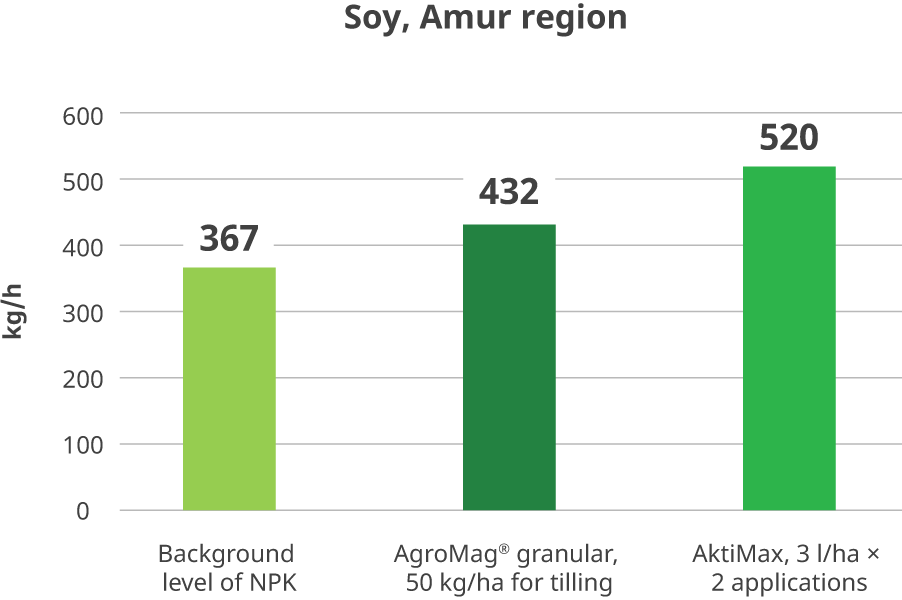
Sunflower, being a crop demanding full nutrition for the formation of green mass and high-quality seeds, is no less responsive to additional fertilization with magnesium and boron (Table 3).
Sunflower seed yield increases from 190 to 600 kg/ha, i.e., an average of 350 kg/ha or (15%) were obtained in different natural and climatic zones.
| Region, soil | Fertilizer* | Yield in experimental plants | Yield increase** | |
|---|---|---|---|---|
| hundred kilograms/ha | % | |||
|
SFD, Krasnodar region. Leached chernozem, meadow-chernozem soil (average over 2 years) |
AgroMag® gr., 120 kg/ha for tilling |
26.4 | 1.9 | 8 |
|
AM 6 l/ha |
27.5 | 3.0 | 12 | |
|
AgroMag® gr., 120 kg/ha for tilling + AM 3 l/ha |
27.4 | 2.9 | 12 | |
|
SFD, Krasnodar region. Ground leached chernozem |
AgroMag® gr.100 kg/ha in autumn for plowing + AM, 3 l/ha |
20.5 | 3.5 | 20 |
|
SFD, Krasnodar region. Meadow-chernozem soil |
AgroMag® gr. MgO+S 57:1, 100 kg/ha for tilling |
28.8 | 4.1 | 17 |
|
Republic of Belarus. Podzolic (conifer woodland) soil |
AM 4 l/ha |
30.0 | 6.0 | 25 |
|
CFD, Kursk region. Gray forest soil |
AgroMag®gr. MgO+B 57:1, 100 kg/ha for tilling |
32.6 | 2.8 | 9 |
In regions with an arid climate, it is recommended to give preference to leaf fertilization with AgroMag® AktiMax suspension in order to reduce the impact of environmental stress factors on plants and to strengthen them during active growth and crop formation.
As a result of insufficient moisture, combined with high average daily air temperatures in the years of the experiment, the magnesium from the fertilizer which had been applied to the soil at a dose of 120 kg/ha during spring tilling was not fully absorbed into the metabolism of sunflower plants (experiment No. 1).
This resulted in a yield gain of 190 kg/ha (8 %) while a single leaf application (6 L/ha) resulted in a yield gain of 300 kg/ha (12 %). Joint application of 100 kg/ha of pellets in the fall during plowing, with subsequent leaf fertilization (3 l/ha) enabled a gain of 3,500 kg/ha or 20% (experiment №2).
Moreover, in a favorable weather year with no spring drought, the yield increase from the application of new AgroMag® granulated grade MgO + B 57:1 fertilizer for tilling in the Yeisky district of Krasnodar Krai, which belongs to the zone of insufficient moisture, was 410 kg/ha without the addition of leaf fertilizer (experiment No. 3).
The level of oil content of sunflower seeds in the experiments in Krasnodar region and Kursk region remained close to the level of oil content in the control plants, despite the increase in yield, and amounted to 47 and 45%, respectively.
Increases in sunflower oil harvest amounted to 102 - 197 kg/ha (9 - 17 %) in Krasnodar region and 134 kg/ha (10 %) in Kursk region relative to the control mineral background levels in the experiments (Fig. 2).
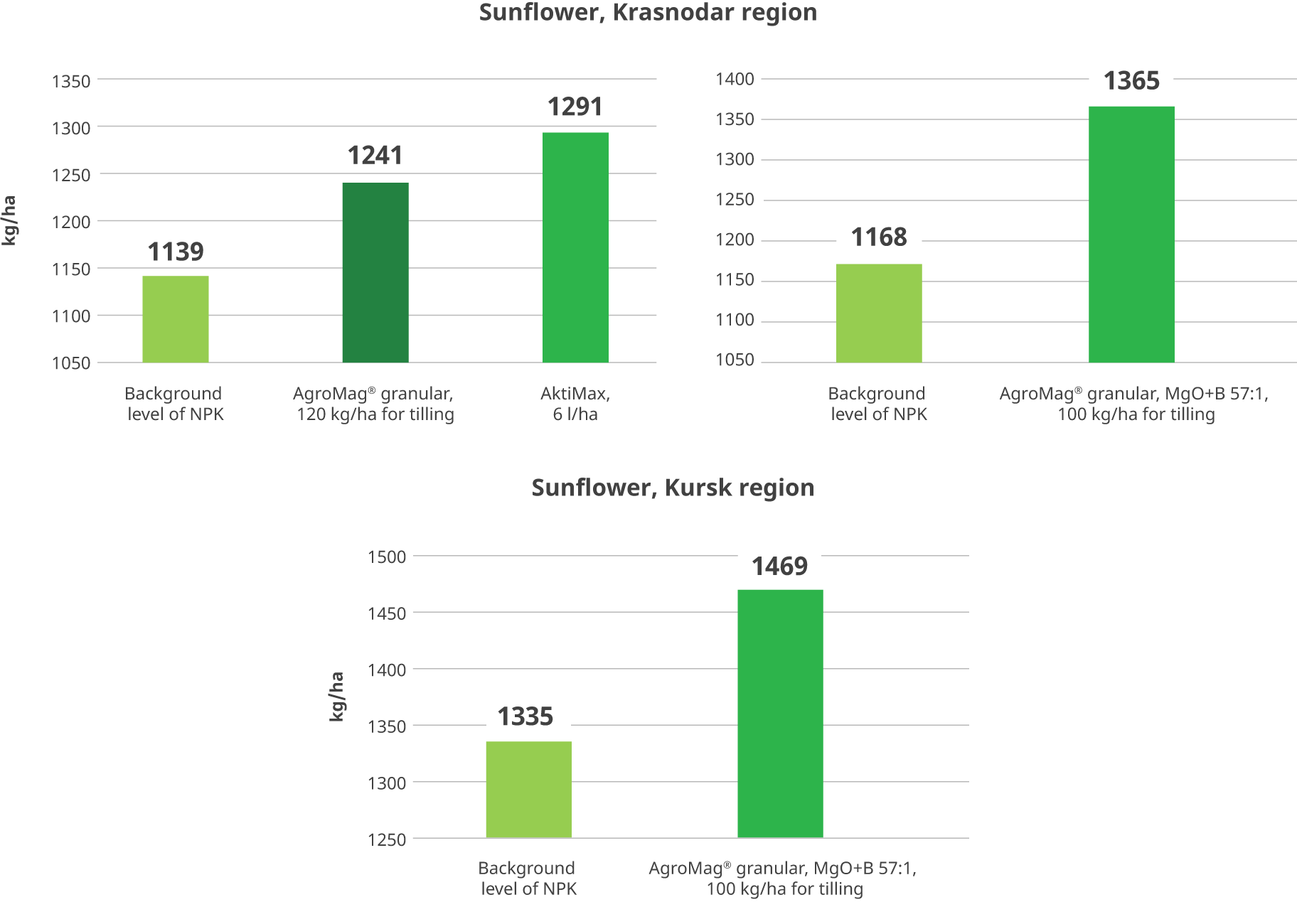
The results of field experiments conducted with spring and winter rape showed that (Table 4):
-
the most effective way to increase yields was the combined application of AgroMag® granules and slurry to the NPK background level;
- addition of magnesium together with sulfur (AgroMag® granulated grade MgO+S 49:20) to the rape nutrition.
As in the experiments with soybeans, the addition of mesoelements (magnesium, sulfur) to the rape nutrition system resulted not only to an increase in yield, but also in an improvement in seed quality.
The oil content of spring rape grown in Moscow region with the NPK mineral background level was 42.8 %. Additional unilateral fertilization with magnesium increased oil content up 43.8 % and with the addition of sulfur to 44.1 %. Oil content from the joint application of magnesium and sulfur to winter rape in Krasnodar region improved the oil content level from 45.0% to 46.2 %. This enabled an increase in oil harvest of 91-171 kg/ha in Moscow region and 72-134 kg/ha in Krasnodar region (Fig. 3).
| Region, soil | Fertilizer* | Yield in experimental plants | Yield increase** | |
|---|---|---|---|---|
| hundred kilograms/ha | % | |||
| Spring rape | ||||
|
CFD, Oryol region. Gray forest soil |
AgroMag® gr., 94 kg/ha for tilling + AM, 4L/ha x 2 applications |
36.0 | 5.0 | 16 |
|
CFD, Moscow region. Podzolic (conifer woodland) soil |
AM, 4 l/ha x 2 applications |
22.8 | 1.9 | 9 |
|
AgroMag® gr., 160 kg/ha + AM, 4l/ha x 2 applications |
24.3 | 3.4 | 16 | |
|
CFD, Moscow region. Podzolic (conifer woodland) soil |
AgroMag® gr. MgO+S 49:20, 100 kg/ha for tilling + AM, 4l/ha x 2 applications |
13.0 | 2.9 | 29 |
| Winter rape | ||||
|
SFD, Krasnodar region. Paddy meadow-chernozem heavy loamy soil |
AgroMag® gr.80 kg/ha when tilling before sowing |
17.6 | 1.3 | 8 |
|
AgroMag® gr. MgO+S 49:20, 100 kg/ha when tilling before sowing |
18.8 | 2.5 | 15 | |
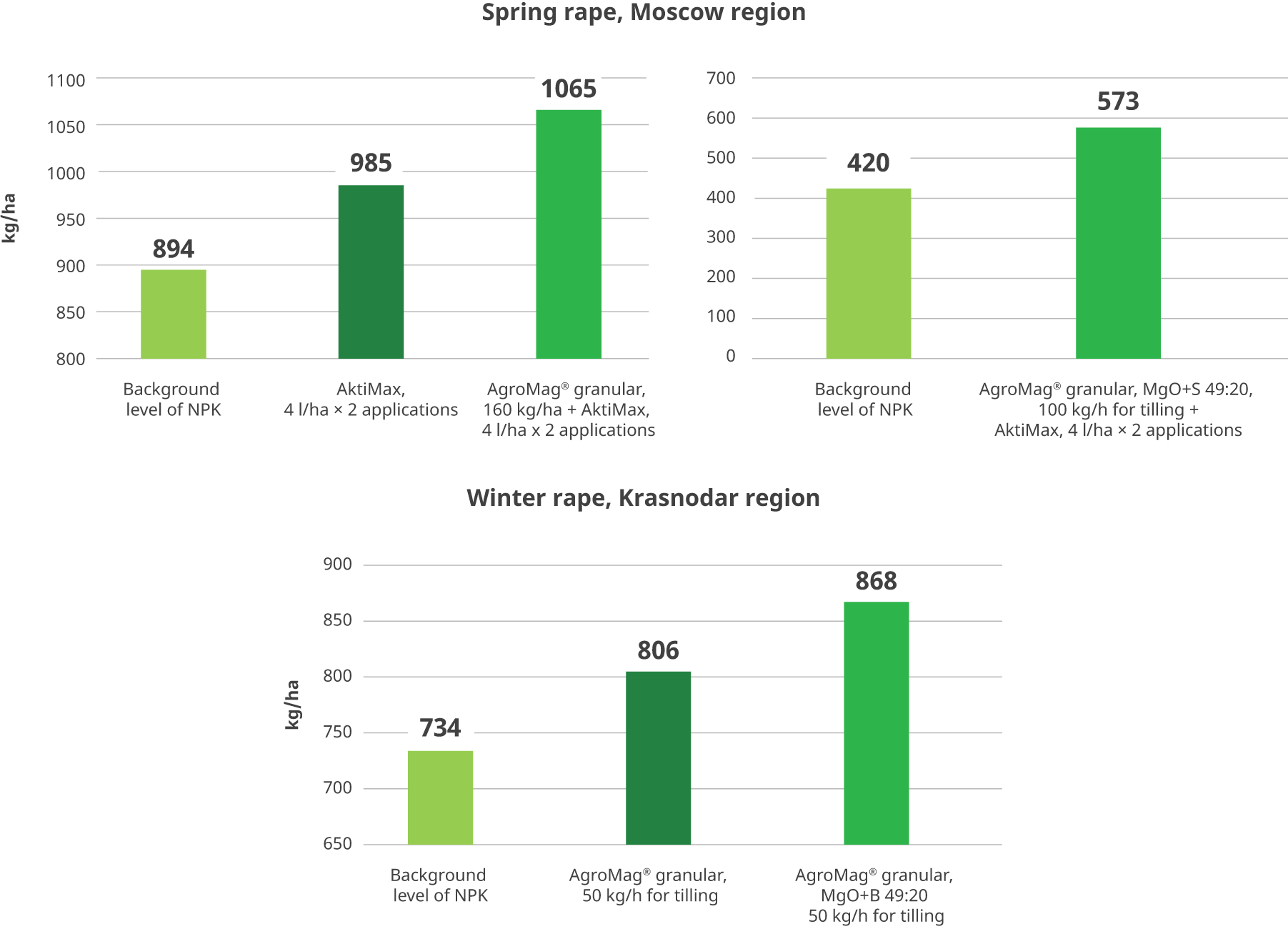
Conclusion
Application of fertilizers in the AgroMag® range in different doses and combinations promotes more balanced nutrition of oil crops and better assimilation of basic nutrition elements from different soils and NPK – fertilizers, which leads to additional growth in productivity and gross oil yield.
